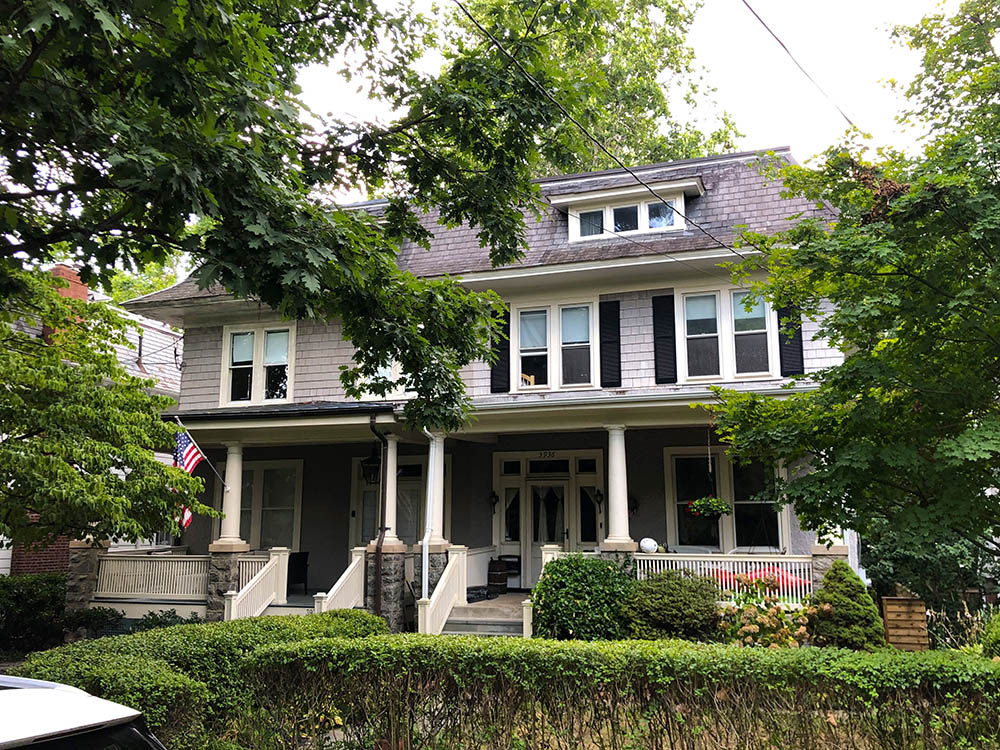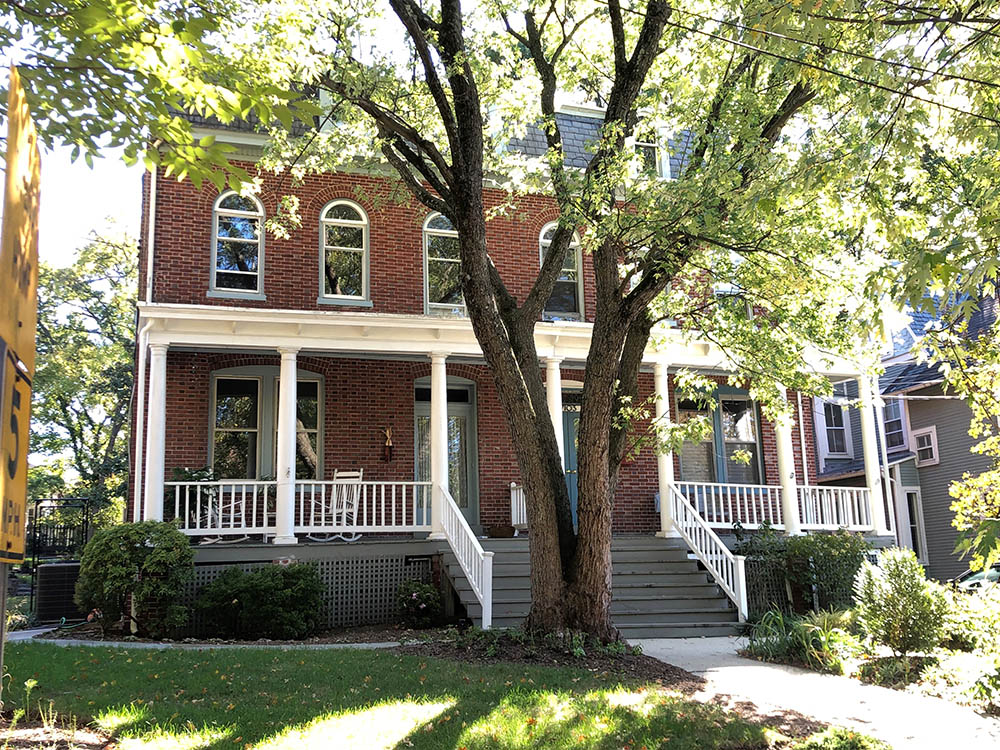With its endorsement of Montgomery Planning’s Attainable Housing Strategies (AHS) in June 2024, the Montgomery County Planning Board has recommended the county adjust its residential zoning to allow property owners the opportunity to build multi-unit houses in neighborhoods that currently only allow single-family houses. The recommended zoning change aims to meet the county’s growing demand for housing at different price points and with different house types, like those offered in most residential neighborhoods throughout the first half of the 20th century and earlier.

A duplex on Morrison Avenue in Washington, DC. that looks like a typical single-family house with porches, dormers and yard setbacks.
Read some of our recent Third Place blogs to go deeper on AHS:
- Give everyone a chance to call Montgomery County home.
- FAQ: Curious about our proposal to relax single-family zoning? We’ve got answers.
- Answers to questions (and misconceptions) about Attainable Housing Strategies
Attainable housing is not a new concept. Multi-unit housing (also called Missing Middle housing) – small apartment buildings, duplexes, triplexes, quadplexes, cottage courtyards, and accessory units such as “granny flats” over a garage – were all part of American neighborhoods prior to World War II in both urban and suburban communities like Chicago, New York, Philadelphia, Washington, DC, Silver Spring, Chevy Chase, and Takoma Park. Larger single-family houses were created on larger lots for those who could afford them while small-lot homes and multi-unit houses, typically less than 1,000 square feet, were built for first-time home buyers. All these housing types were mixed into neighborhoods and connected by walkable tree-lined streets linking them with parks, schools, places of worship, and amenities. A diversity of housing types created diverse neighborhoods where people of all ages, family sizes, and economic resources could live side by side.
Today in Montgomery County’s residential zones, most of these multi-unit house types are illegal. Duplexes can be built in some zones, but it requires additional process and time thereby effectively preventing their construction. Single-family detached homes in Montgomery County are allowed by right while multi-unit house-like structures, often looking no different than a house, are not permitted. Unnoticeable to most people, there are historic examples of Missing Middle housing in Silver Spring, Takoma Park, Chevy Chase, and Bethesda. There are also some in newer master-planned, small-scale residential neighborhoods like Kentlands and King Farm in Gaithersburg. All these existing Missing-Middle-type homes have standard detached-house setbacks and look like ordinary homes even though they feature multiple, smaller units.
The lack of new housing, residentially zoned lots with large minimum lot size requirements, and a dramatic reduction in housing types, especially in walkable areas, have contributed to housing prices going through the roof, pricing many residents out of inner circle neighborhoods. The current average price of a single-family detached home in 2024 is over $1 million in Montgomery County.

A 2.5-story duplex with a mansard roof, large porch, and standard residential setbacks in Takoma Park, MD.
Today, over 65% of Montgomery County households have one or two people. Nationally, this number is 80% and growing. The idea behind Attainable Housing Strategies is that it offers more opportunities for this large demographic. Returning young adult children who want to live in their family’s neighborhoods as first-time home buyers could take advantage of these types. Ideally this would allow singles, partners, and/or beginning families to find housing closer to jobs and amenities with a middle-income salary. Attainable housing also provides opportunities for empty nesters to downsize from their larger house and stay in their family’s neighborhood if they choose. The only other option within the county is to downsize to a large apartment building or townhouse outside their neighborhood, which many do not prefer.
A growing list of cities and states across the country are adjusting single-family zones to meet the needs of their growing and changing populations. The reintroduction of historical Missing Middle or attainable housing types is one way to meet these needs more affordably using existing infrastructure. The Planning Board’s 2024 Speaker Series panel discussions gathered practitioners in the field who have done this and found significant success. Watch the October 17 panel discussion to see what these experts say happens if jurisdictions do nothing to address a housing shortage.
Diversifying single-family neighborhoods with some different types of houses has been, and continues to be, a valuable tool in the United States to help people find a place to call home in the communities they love. We have a housing crisis in Montgomery County and across the country. Attainable Housing Strategies is one way to attempt to address this problem in an aesthetically pleasing, historically appropriate, economically viable, and environmentally feasible way.
On November 19, 2024, the Montgomery County Council was briefed on the community’s recent feedback on the Planning Board’s AHS recommendations. Council members are still taking the public’s comments, and there is no legislation before them at this point. Stay updated on the process by regularly checking the County Council’s website.

About the author
Paul Mortensen is the Senior Urban Designer in the Director’s Office at the Montgomery County Planning Department and leads the Design Excellence program. He is a registered architect in California, Washington, and Maryland, is a LEED-Accredited Professional, and is a member of the Congress for New Urbanism.
Rudy E.
Why does Planning work in concert with creepy Dan Reed? It’s shocking that this guy is compiling a list of enemy names, their addresses, birthdates, party affiliations, and running them through some kind of program that guesstimates their race. This guy is way over the line and will stop at nothing to intimidate those who disagree with him. And that you work with him makes you complicit in his creepiness.
“ I filed a Maryland Public Information Act (MPIA) request for the names of everyone who signed up to attend a listening session. I received a list of 1607 names, and GGWash board member Jonathan Robinson matched those names to an August 2024 copy of the voter file, resulting in a list of 1037 individual people, each connected to an address in the county, a birthdate, and party affiliation. Jonathan then used a method called Bayesian Inference with Surname and Geocoding to infer other demographic traits for each person, similar to what the researchers used in the book Neighborhood Defenders.”
Schmark
Why do they comply with public records law? Last comment is bizarre. The degree to which the public feedback mechanisms used to gauge reactions failed to capture the involvement of beneficiaries of attainable housing was fascinating and anonymous. Comical to pretend it was a public enemy list.